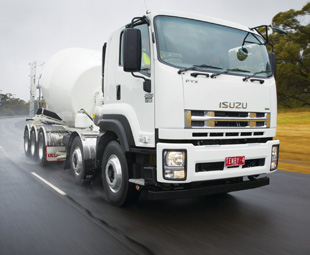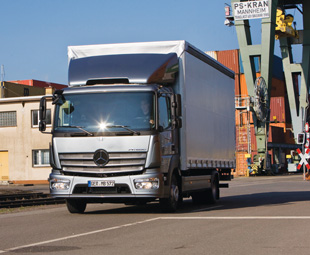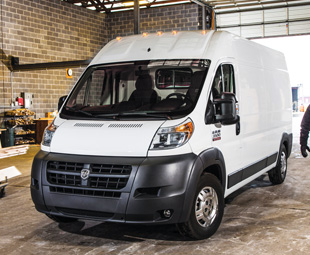Isuzu eight-leggers agitate in Australia …

In his monthly review of global news for local truckers, FRANK BEETON looks at some very interesting new multi-axle Isuzu extra-heavies that have appeared in Australia, picks up early news of Mercedes-Benz’s new Atego cruiserweight, further expands the Arocs story from the last issue and reports on the Fiat Ducato’s imminent entry to the US van market with RAM branding.
Maintaining truck market leadership in any country for 24 consecutive years is a major achievement. When that market is in a particularly demanding country like Australia, where the regulatory environment is challenging (operating conditions are similar in many respects to our own here in South Africa) and transporters have very definite ideas about want they want in a truck and the standard of product support that they expect, the achievement becomes even more creditable. At the very least, it says that Isuzu Australia Limited (IAL) must have a very clear understanding of its customers and their preferences, and that it has achieved a high degree of consistency in delivering the required standards of product, support, and even promotional activity, that the market deems appropriate.
IAL has assimilated the hard truth that trying to shovel any off-the-shelf product (configured in some distant design office), down the throats of its customers, is not the way to go. The unique combination of Australian legislation and operator preferences, developed over many years of hard-won experience, has resulted in very distinct configurations being favoured for specific applications, and one of these is the four-axle, twin-steer, rigid eight-wheeler, which has become the first choice of many truck-mixer – or in Australian parlance – “agitator” operators. Quite simply, the absence of such a model from any manufacturer’s catalogue will disqualify it from access to this important niche in the local heavy-duty market for multi-axle trucks, which, in addition to the aforementioned “agitators”, also includes concrete pumpers, hook-lift multibody units, front-loading refuse collectors, tippers and tankers.
In its continuing pursuit of even greater market share, IAL recently launched no less than nine new model variants, aimed squarely at exploiting this market segment which had previously been inaccessible to the brand. Designated the “FY” Series, these units reportedly share the basic chassis frame of Isuzu’s Giga flagship,
but utilise the cab from the lighter FX Series, which is made up of two- and three-axle models.
The important adaptation required to enter the four-axle category was the development of a suitable twin-steer front axle group, and in this respect Isuzu Motors in Japan has pushed the envelope by designing a load-sharing system utilising rocker arms to link the first and second axle spring packs, with adjacent shock absorbers to damp out any excessive bounce tendencies. The FY series uses Meritor axles all round, with steel four-spring front suspension, and a choice of Isuzu trunnion/6-rod steel or Hendrickson air-suspension for the tandem-drive
rear bogie.
Having gone to the trouble of developing an eight-wheeler specifically to suit Australian requirements, Isuzu pushed on to the next logical step by also adding the FYX 2500 10×4 to the lineup. This necessitated the addition of an automatically lifting fifth axle, mounted on a Hendrickson HLM2 trailing-arm air suspension, aft of the tandem drive bogie, thus raising the Gross Vehicle Mass rating from the 30 tonnes of the eight 8×4 variants to 35 tonnes in the case of the 10×4. The common driveline specification includes Isuzu’s 9,8-litre SITEC Series III 350 engine, rated at 257 kW (345 hp), driving through a choice of Eaton’s RTLO 11908LL 10-speed constant mesh, ZF’s 9S 1310 TO 9-speed synchromesh, or Allison HD 4430 fully-automatic transmissions. Consistent with the intended truck-mixer application, an engine-driven PTO has been made available to enable drum rotation on the move.
The introduction of these models signals a very significant departure from “normal” Japanese product planning practice. In the past, the usual design philosophy for addressing the specific needs of an individual market was to take existing standard domestic or export products, and with the minimum of alteration, fit them as closely as possible to the intended purpose. In the case of competing European manufacturers, however, individual truck models were seen as merely a unique combination of standardised individual components, or “aggregates”, sourced from the corporate parts bin. The latter approach resulted in a more flexible “bottom up” process for creating a new, optimised, product for any specific purpose.
This discussion is particularly appropriate when examining the case, in point, of an 8×4 rigid truck. The four-axle configuration is fairly popular in Japan, and most domestic manufacturers have such models in their home market catalogues. However, the Japanese models are usually fitted with tiny 16-inch wheels at the rear, to lower the loading height. This considerably complicates the task of re-engineering the base model to satisfy heavier-duty export requirements, whereas the more practical alternative of creating a new combination of existing standard components, already used on other models, was not part of the accepted cultural modus operandi.
With this as background, Isuzu’s development of these highly specialised 8×4 and 10×4 models for Australia is to be applauded. It is, hopefully, early evidence of a new, more flexible and progressive approach to product engineering by a leading Japanese truck manufacturer which, if regularly applied, can only benefit its sales performance in other international export markets.
And now, a new Atego!
Recent Global FOCUS columns have been full of news regarding Mercedes-Benz’s new European heavy-duty truck family, made up of Actros, Antos and Arocs model ranges. It came as quite a surprise, therefore, to learn in mid-February, that the Atego cruiserweight family had also been given “the all-new treatment”.
 It is quite unusual for a truck manufacturer to launch so many new models, covering an extremely wide spectrum of applications, in such a short space of time. In a little more than 18 months, Mercedes-Benz has renewed its entire European truck range from 6,5 tonnes GVM to the heaviest multi-axle models, and one can only imagine the frenetic activity that this must have necessitated in all divisions of the company; from product planning, to engineering, development, public relations, sales promotion, training and right through to preparation of the dealer network.
It is quite unusual for a truck manufacturer to launch so many new models, covering an extremely wide spectrum of applications, in such a short space of time. In a little more than 18 months, Mercedes-Benz has renewed its entire European truck range from 6,5 tonnes GVM to the heaviest multi-axle models, and one can only imagine the frenetic activity that this must have necessitated in all divisions of the company; from product planning, to engineering, development, public relations, sales promotion, training and right through to preparation of the dealer network.
Notwithstanding normal competitive imperatives, the main driving force behind this comprehensive product renewal has been the implementation of the Euro-6 emissions regime starting from the beginning of 2013. To cover this requirement, Daimler Trucks has developed an all-new diesel engine family for the Atego short-radius distribution models, as well as the lower reaches of the Antos and Arocs heavy-duty line-ups, carrying the designations OM934 (4-cylinder) and OM936 (6-cylinder). The cubic capacity of these power units works out at 5,1 litres and 7,7 litres, respectively, and the power spectrum extends from 115 kW (156 hp) to 220 kW (299 hp). Power is transmitted through six- or eight-speed automated transmissions, or power-assisted manual transmissions available with six or nine forward ratios.
Other standard features include electronic stability control, two-stage high-performance engine brake, disc brakes all round, and a permanent magnet electronic retarder. Atego GVM ratings range from 6,5 tonnes to 16 tonnes, and the all-new cab design follows the general styling theme set by the latest heavy-duty models. This will make the new Atego look considerably more aggressive than its “friendly” predecessor, and it was noted that the preliminary artists’ impressions that accompanied the announcement release suggest a higher cab profile than on the previous model. This may cause some concern for distribution drivers who frequently have to leave their cabs to load and unload goods. However, a more accurate assessment of this situation will only be possible once detailed dimensions have been published.
The new Atego range will be exhibited at the Birmingham Commercial Vehicle Show in England during April, and sales are scheduled to commence at the beginning of May.
More Gen on the Arocs
Subsequent to last month’s initial report on Mercedes-Benz’s new construction heavyweight, the Arocs, we have gleaned some important additional information which has prompted the re-opening of the subject. The obvious benefit of the application-specific new range philosophy, that has now been adopted by Daimler Trucks for its European line-up, is that special features, needed to address unique operating conditions, can be built into baseline specifications, without disturbing the competitiveness and marketability of models intended for completely different work environments. For example, measures to accommodate the rugged off-road conditions frequently found in construction applications, characterised by reduced traction and variable load parameters, usually take the form of increased ground clearance and an increased number of drive axles. However, the increased ride height and added mass associated with these features would be completely inappropriate for long-distance on-highway haulage duties, where driveline mechanical efficiency, productivity and economy of operation are the paramount considerations.
Special Arocs features include a facility in the enhanced PowerShift 3 automated eight-, 12- or 16-speed transmissions which provides direct shifting from first to reverse without entering the neutral position. The rocking motion, thus enabled, can be used as a technique to dislodge a vehicle bogged down in soft underfoot conditions. A new crawl function also increases starting torque and facilitates manoeuvrability at low speeds. Operators preferring manual transmissions can specify optional nine- or 16-speed units at extra cost.
Mercedes-Benz has also now adopted hydraulic-drive technology for the front axles of vehicles requiring occasional all-wheel-drive capability. In this system, hydrodynamically driven wheel hub motors are brought into play when additional traction is required, obviating the need to locate expensive and heavy propeller shafts and differentials at the front of the truck. Permanent mechanical all-wheel-drive is also available for the most severe conditions, utilising the VG 2800 transfer case with 100 percent lock-up. Servotwin speed-sensitive electro-hydraulic steering with active steering return is used on four-axle Arocs models, and this is claimed to bring unprecedented levels of steering comfort and accuracy to heavy trucks.
Mercedes-Benz is reportedly also busy with the development of an even more powerful version of its OM 473 15,6-litre HDEPS engine than the 466 kW (625 hp) 3 000 Nm variant already announced for Arocs and New Actros applications. Some time ago, we suggested that Daimler may be considering an assault on Volvo’s “World’s Most Powerful Truck” crown, currently held by the 551 kW (750 hp) version of its FH16 flagship. With all the state-of-the-art features displayed by the OM 470 family, including turbo-compounding and fully electronic 2 100-bar X-pulse injection, it is surely only a matter of time before some Daimler engineer finds the balance between meeting the latest emission standards and optimum output. Stay tuned!
For Ducato, read ProMaster.
The corporate relationship between Chrysler and Fiat, established after Chrysler LLC’s period of Chapter 11 Bankruptcy Protection in 2009, has already produced a considerable number of transatlantic product exchanges. Up until now, most of these have been in the passenger car and SUV categories, but early last year, we broke the news that a Ram-badged Fiat Ducato integral panel van was to be built in the Chrysler complex in Saltillo, Mexico, for introduction to the North American market from 2013. This followed a period when several European van products from the Fiat family, including the Iveco Daily range, were reportedly being considered for Stateside sale, but it has now been confirmed that the Ducato has got the nod.
 Chrysler renamed its erstwhile Dodge Truck Division as Ram Trucks in 2009. Previously, Ram had been the range name of Dodge’s pickup family, but the new branding strategy was introduced to accompany a general shake-up after Fiat effectively took control of Chrysler. Last September, Ram announced the setting up of a new commercial truck division, suggesting that it was setting its sights beyond the sale of pickups to private owners, and placing more emphasis on fleets and small businesses. It should be remembered, however, that Chrysler had marketed a Dodge-badged version of the Mercedes-Benz Sprinter van during the DaimlerChrysler era that ended in 2007. The termination of that arrangement had left a void in the Chrysler product range that has not been filled up to now.
Chrysler renamed its erstwhile Dodge Truck Division as Ram Trucks in 2009. Previously, Ram had been the range name of Dodge’s pickup family, but the new branding strategy was introduced to accompany a general shake-up after Fiat effectively took control of Chrysler. Last September, Ram announced the setting up of a new commercial truck division, suggesting that it was setting its sights beyond the sale of pickups to private owners, and placing more emphasis on fleets and small businesses. It should be remembered, however, that Chrysler had marketed a Dodge-badged version of the Mercedes-Benz Sprinter van during the DaimlerChrysler era that ended in 2007. The termination of that arrangement had left a void in the Chrysler product range that has not been filled up to now.
Full details have now emerged of the Ram ProMaster, the name to be carried by the Ducato derivative range that will be sold in North America from the third quarter of 2013. The specification for the “purpose-built, full-size van segment” of the US market will include a four-cylinder in-line 3,0-litre EcoDiesel developing 130 kW (174 hp), or, alternatively, a 3,6-litre DOHC Pentastar V6 rated at 210 kW (280 hp) for customers following the traditional American preference for petrol engines. Drive to the front wheels is via a 62TE six-speed automatic transmission, or six-speed automated mechanical M40 gearbox, and there are a total of 13 available configurations, based on two roof heights, three wheelbases and four body lengths. The ProMaster will also be available in chassis-cab and “cutaway” versions, for final completion to end-user specifications by aftermarket bodybuilders and conversion specialists.
Although the ProMaster will lean heavily on the well-established Ducato basic design (which now boasts a production history of more than 30 years, with more than 4,5 million sales under its belt) several adaptations have been made to better fit the product to American preferences.
Much is also being made of the front-wheel-drive layout with all powertrain and driveline components located forward of the load area. This provides loading height and load space benefits, with greater adaptability for specialist conversions. This emphasis is an obvious response to the growing popularity of Mercedes-Benz’ rear-drive Sprinter integral van in the United States market. ProMaster will also incorporate 35 safety and security features including six air bags and electronic stability control technologies.
This first manifestation of Ram’s new Eurocentric product direction has raised questions about the continuing existence of its lighter commercial van, which is currently derived from the multi-purpose vehicle known as the Dodge Grand Caravan or Chrysler Town & Country. Earlier expectations that Chrysler was also considering the importation of Fiat Doblo light vans into North America to compete with Ford’s Transit Connect seem to have become less certain with the publication of the manufacturer’s latest product plan. However, should the Transit Connect, Nissan NV200 or other global products prove enduringly popular in North America, this option could be revisited in the near future.
Global FOCUS is a monthly update of international news relating to the commercial vehicle industry. It is compiled exclusively for FOCUS by Frank Beeton of Econometrix.
Published by
Focus on Transport
focusmagsa




